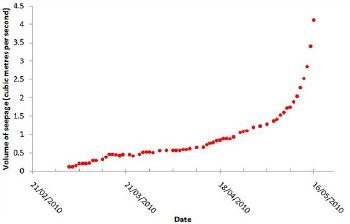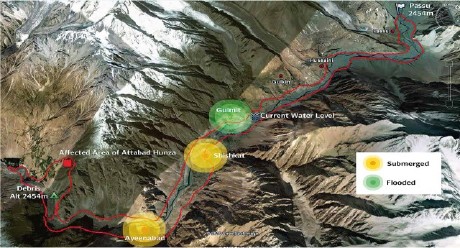Adil Najam
(Editors note: We are reposting this because ATP believes that this issue needs and deserves much more public attention than it has recieved).
For the last many days now I have been following the news from Attabad and Hunza region. The news has not been good. To get a sense of the magnitude of what is happening here, just take a look at this recent video of a landslide in Hunza:
In fact, I would argue that the Hunza landslide is the single worst news confronting Pakistan today amongst all the bad news we are bombarded with. Worse than the news of a wannabe terrorist in New York, worse than TV news-anchor scandals, worse than Presidential pardons for Rahman Malik, and certainly worse than the fuss in a teacup over some Facebook page. What has been happening with the Hunza landslide is utterly catastrophic in terms of its natural as well as human impacts. This is a real calamity with real human victims and one that has already put the lives and livelihoods of not dozens but thousands of people at real risk today and will do so into the future.
I have been following the events up in Attabad and the Hunza region with growing trepidation – constantly hoping that maybe things would subside or get better or someone will figure out what to do. They have not. In fairness, the hope was a false and unrealistic one since very little can be done at this stage beyond better management for those multitudes who have been displaced in this catastrophe.
Here is an early glimpse of what this means to the lives of thousands of real people.
And this, all indications suggest, is just the beginning. As so often happens in disasters such as this, things are likely to get a lot more worse before they get any better. This news report in The Express Tribune explains how the lake is expected to breach its barrier by May 26:
As another landslide plunged into Attabad Lake on Tuesday, the Hazara division is expected to bear the worst brunt of an imminently approaching breach of the massive artificial lake.
Officials suspended boat service, the only current form of travelling downstream across the blocked Karakoram Highway (KKH), citing unsafe conditions. “We will start helicopter service in place of boat service,†said Wazir Baig, Speaker Gilgit-Baltistan assembly to The Express Tribune. “You see, landslides are constantly occurring and we can’t afford that people further suffer due to these kinds of incidents,†he added.
According to reports, landslides triggered by torrential rains cut off Gilgit-Baltistan from the rest of the country due to road blocks on at least four points near the Kohistan and Chilas areas. Tuesday’s landslide occurred at exactly the same point where the original avalanche blocked the Hunza River in January, creating the artificial lake that has inundated several villages upstream. Wazir Baig, along with deputy commissioner Hunza, was inspecting relief work at the site when heavy rock fall and boulders shook the area and struck the Attabad Lake, threatening a possible overflow within a few days time.
Authorities have warned that a rupture in the barrier could submerge at least 36 villages downstream, including Sarad and Mayon in the surrounding Nagar Tehsil, and as far as Kohistan and Chilas. People have said that government officials alerted various villages downstream, making evacuation announcements through loudspeakers in mosques. The impending flash flood is threatening nearly 18,000 living people downhill, possibly impacting areas all the way to Tarbela Dam…
Meanwhile, DCOs of Kohistan, Batagram, Hazara, Manshera, Abbotabad and Haripur districts also met on Tuesday to review possible complications arising from the dangerous situation. About 25 feet short of the 30 meter spillway dug by the Army, the Attabad Lake is likely to cross the barrier by May 26. Hazara Division stands to lose worst of all, while countless bridges constructed over the river Sindh were equally at risk, reported a news agency.
“The resulting chain reaction may also damage installations on the Indus River of which the Hunza River is a tributary,†the head of the flood forecasting division of the Pakistan Meteorological Office, Hazrat Mir, was quoted as saying in a report by IRIN, United Nations. Official statistics report that the lake’s current water level was at 348.6 feet while the inflow recorded on Tuesday was 3.8 feet. The length of the lake expanded beyond 28 kilometers.
I have been looking for information on exactly what is happening and why, because knowledge itself becomes a casualty in many disasters, and that itself has been difficult to come by. I am grateful to ATP reader Rehan Farooqi for alerting me to the website of Prof. David Petley of Durham University who has been keeping a much closer eye on this than I have and whose website is worth a visit for anyone wishing to understand what is happening here.
 This graph, for example, shows just how quickly the seepage has been increasing since the January landslide, and how the seepage has increase exponentially with the warmer temperatures and recently (especially since now we have a fourth seepage point).
This graph, for example, shows just how quickly the seepage has been increasing since the January landslide, and how the seepage has increase exponentially with the warmer temperatures and recently (especially since now we have a fourth seepage point).
On May 12, Prof. Petley posted this new image from NASA – on deciphering which he has worked – which captures the Hunza River on May 2, 2010 and on which the outline shows the growth in the lake area since mid-March 2010 (click on image for the NASA page with commentary and larger image. Click here for further commentary from prof. Petley on his website).
The commentary on this GIS image is instructive in understanding what has been happening:
On January 4, 2010, a landslide dammed the Hunza River in northern Pakistan, creating a lake that threatened to overflow its earthen dam and flood downstream communities. By mid-March 2010, the lake was 7 miles (10 kilometers) long. By early May, the lake had expanded well beyond its mid-March extent. As spring progressed, warmer temperatures began melting snow, which raised the rate of inflow to the lake.
The Advanced Spaceborne Thermal Emission and Reflection Radiometer (ASTER) on NASA’s Terra satellite captured this false-color image of the landslide lake on the Hunza River on May 2, 2010. Blue indicates water, red indicates vegetation, and shades of beige and gray indicate bare rock. The approximate extent of the lake on March 16, 2010, appears as a white outline. This image has been rotated, so north is to the right.
The river-blocking landslide appears near the upper left corner of this image. Next to the landslide, water levels have risen compared to their mid-March extents, and higher water is evident along the entire lake. In mid-March, north of the landslide lake, the Hunza River was a narrow tributary. In this scene, however, the water body is swollen well past the previous lake extent.
Compared to the largely barren slopes nearby, low, broad plains along the river support abundant vegetation (red in this type of image) associated with settlements. Video footage of settlements along the rapidly growing landslide lake, however, shows partially submerged trees and homes, as well as residents demolishing their homes to salvage building materials.






















































Its very clear that Govt is deliberately trying to worsten the situation to get international funding on this issue.
The spillway level which is deliberately kept so high to create a huge lake & to drawn the villages behind in the lake, is clearly explaining the male0intentions of Govt.
But the people are so foolish that they never understand the conspiracy against them by the so called democratic politicians.
Geo Jamhooriat….
We deserve this brutality
Dear Ahsan Farooq, Intelligence Officer, NAB
After you have said this “The Husnza disaster means nothing to me. What would happen if few million people died in the event. “, I don’t think that there is any point in arguing with you.
Please do us all a favor and do not call yourself Muslim or Human again.
Ahsan Farooq,
If you have no respect for human life, how could you even call yourself a human let alone a Muslim. Do you remember the story about Hazrat Muhammad PBUH was cursed at and trash dropped at by the old lady? If you do then you won’t worry about standing up to gaurd the respect for our prophet. I am more than positive that he can take care of that himself with out your help, thank you very much. If you don’t this is is bigger than all the topics mentioned in the article then my friend you need to wake up. Please get some education and open your mind. Why do you think you can do better than Allah in terms of taking care of his beloved prophet, do you have more power? Stop being an idiot and listen to what you are saying. People like you make Muslims weaker than they are, if you really want to do something come up with a solution to fight back online. You want to die, why? Don’t you think you could educate more people by living and talking and explaining what Islam is about.
Now, back to the real disaster that is happening, if there is anything you could do to help you should do that because this will not only effect Hunza but the entire country. Where will this water end up? What will all this water do along the way?
Please think about the things you have control over and let Allah and his Rasul PBUH take care of themselves.
People killed by the terrorist are given so much hype. People disturbed by such natural disasters should be given the same care I believe. It is important we curb this as well.
The solution will require thinking and hard work. On the other hand boycotting facebook and ranting on Internet is easier so Pakistanis will choose that path instead.